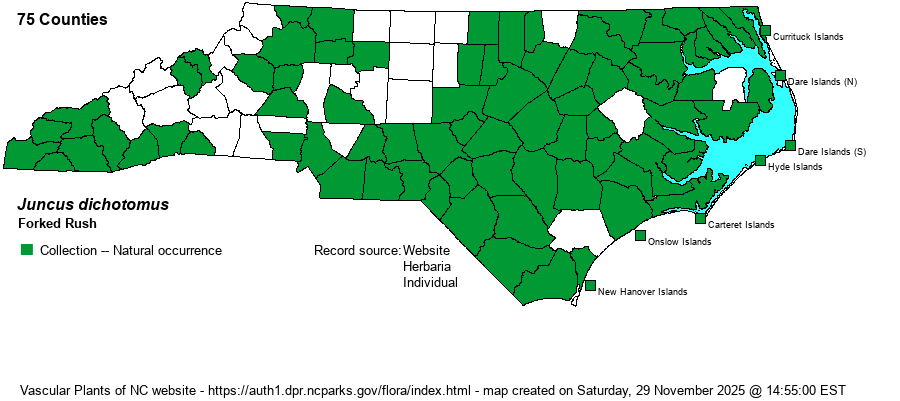| Author | Elliott | |
| Distribution | Essentially throughout the state; the gaps shown on the map will likely be filled with additional collecting.
MA to PA and OH, south to central FL and TX; Mex., C.A., S.A. | |
| Abundance | Frequent to locally common in the Coastal Plain, Sandhills, and the southeastern Piedmont. Infrequent in the Mountains and the central/western Piedmont. With collections from 75 counties, the State Rank is certainly S5, and not anywhere near the S3S4 as assigned by the NCNHP. | |
| Habitat | Dry to moist sandy soils of fields, meadows, pine-hardwoods of various compositions, maritime woodlands, maritime dry grasslands, clearings, powerlines, roadsides. Occurs in drier and more disturbed habitats than most other Juncus species. | |
| Phenology | Flowering and fruiting May-September. | |
| Identification | Forked Rush typically grows 1-2 feet tall, several stems together. Leaves are all basal or near-basal, slender, and vary from round in cross-section to rather flat. The inflorescence is terminal and short-branched, with a few to several heads generally crowded on each branch. Three other species in NC look very similar. Path Rush (J. tenuis) has a long, tongue-like auricle (extension) at the tip of each leaf sheath (vs. short). In Georgia Rush (J. georgianus) and Lopsided Rush (J. secundus) the lowest involucral bract (at the junction of the stem and inflorescence) is shorter than the inflorescence (vs. usually longer); note also their specialized habitats. | |
| Taxonomic Comments | Includes J. platyphyllus, which represents the flat-leaved end of the spectrum.
NOTE on Juncus: These "grasslike" or "sedgelike" plants occur in most habitats, especially where moist or wet. They can immediately be told from grasses and sedges by the presence of 6 tepals (petal-like) that surround the fruit. These tepals can be thought of as analogous to sepals and petals of, say, lilies or trilliums. Most species have brown, chestnut, or reddish tepals and dark brown fruits. The flowers occur in few- to many-flowered heads. Leaves are nearly all basal and round in cross-section. Stems are unbranched, except for the inflorescence. Fruits are termed capsules and contain many tiny seeds. | |
| Other Common Name(s) | None | |
| State Rank | S3S4 [S5] | |
| Global Rank | G5 | |
| State Status | | |
| US Status | | |
| USACE-agcp | FACW link |
| USACE-emp | FACW link |

